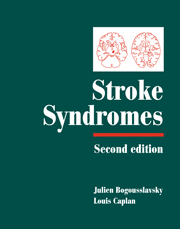Book contents
- Frontmatter
- Contents
- List of contributors
- Preface
- PART I CLINICAL MANIFESTATIONS
- PART II VASCULAR TOPOGRAPHIC SYNDROMES
- 29 Arterial territories of human brain
- 30 Superficial middle cerebral artery syndromes
- 31 Lenticulostriate arteries
- 32 Anterior cerebral artery
- 33 Anterior choroidal artery territory infarcts
- 34 Thalamic infarcts and hemorrhages
- 35 Caudate infarcts and hemorrhages
- 36 Posterior cerebral artery
- 37 Large and panhemispheric infarcts
- 38 Multiple, multilevel and bihemispheric infarcts
- 39 Midbrain infarcts
- 40 Pontine infarcts and hemorrhages
- 41 Medullary infarcts and hemorrhages
- 42 Cerebellar stroke syndromes
- 43 Extended infarcts in the posterior circulation (brainstem/cerebellum)
- 44 Border zone infarcts
- 45 Classical lacunar syndromes
- 46 Putaminal hemorrhages
- 47 Lobar hemorrhages
- 48 Intraventricular hemorrhages
- 49 Subarachnoid hemorrhage syndromes
- 50 Brain venous thrombosis syndromes
- 51 Carotid occlusion syndromes
- 52 Cervical artery dissection syndromes
- 53 Syndromes related to large artery thromboembolism within the vertebrobasilar system
- 54 Spinal stroke syndromes
- Index
- Plate section
54 - Spinal stroke syndromes
from PART II - VASCULAR TOPOGRAPHIC SYNDROMES
Published online by Cambridge University Press: 17 May 2010
- Frontmatter
- Contents
- List of contributors
- Preface
- PART I CLINICAL MANIFESTATIONS
- PART II VASCULAR TOPOGRAPHIC SYNDROMES
- 29 Arterial territories of human brain
- 30 Superficial middle cerebral artery syndromes
- 31 Lenticulostriate arteries
- 32 Anterior cerebral artery
- 33 Anterior choroidal artery territory infarcts
- 34 Thalamic infarcts and hemorrhages
- 35 Caudate infarcts and hemorrhages
- 36 Posterior cerebral artery
- 37 Large and panhemispheric infarcts
- 38 Multiple, multilevel and bihemispheric infarcts
- 39 Midbrain infarcts
- 40 Pontine infarcts and hemorrhages
- 41 Medullary infarcts and hemorrhages
- 42 Cerebellar stroke syndromes
- 43 Extended infarcts in the posterior circulation (brainstem/cerebellum)
- 44 Border zone infarcts
- 45 Classical lacunar syndromes
- 46 Putaminal hemorrhages
- 47 Lobar hemorrhages
- 48 Intraventricular hemorrhages
- 49 Subarachnoid hemorrhage syndromes
- 50 Brain venous thrombosis syndromes
- 51 Carotid occlusion syndromes
- 52 Cervical artery dissection syndromes
- 53 Syndromes related to large artery thromboembolism within the vertebrobasilar system
- 54 Spinal stroke syndromes
- Index
- Plate section
Summary
Introduction
The causes of spinal ischemia are as multiple as those of cerebral infarction and frequently, especially in young individuals, no definite etiology can be delineated. The concepts are also basically the same: reduced arterial blood supply may cause territorial infarctions in the case of vessel occlusion or embolism, or watershed infarctions in the case of generalized ischemia. This may be transient (spinal transient ischemic attacks, TIA) or permanent (cord infarction). If venous drainage is reduced or venous pressure increased, a congestive myelopathy may evolve which contrary to arterial disease usually shows a fluctuating and chronic progressive course.
Blood supply to the spinal cord
At the fetal stage the spinal cord is provided with an extensive arterial network guaranteeing arterial blood supply. This extensive network, however, gradually regresses during maturation.
Arterial
Three main levels of arterial blood supply can be differentiated: (i) The vertebral arteries and the segmental arteries arising from the aorta give rise to the radicular arteries; the numbers and locations of radiculomedullar arteries contributing to the cord supply are quite variable, individually they form the spinal region (cervical, thoracic, lumbar and sacral)(Fig. 54.1). (ii) The radiculomedullar arteries feed the extrinsic intraspinal arterial network consisting of the three longitudinal discontinuous channels (anterior and pair of posterior spinal arteries) connected among each other via the spinal arterial plexus (vasa coronae) (Fig. 54.2 and 54.3). (iii) The intrinsic (intramedullary) arterial supply arises from this (perimedullary) spinal arterial plexus and these vessels are endarteries i.e. without collaterals: the sulcocommissural arteries and the circumferential perforating (or penetrating)(medullary) arteries (Fig. 54.3) (Lazorthes et al., 1971; Romanes, 1965).
- Type
- Chapter
- Information
- Stroke Syndromes , pp. 691 - 704Publisher: Cambridge University PressPrint publication year: 2001
- 1
- Cited by



